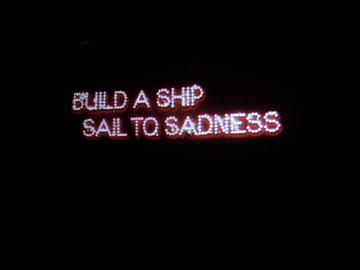
It was with a feeling of excitement that I got stuck into David’s latest book – Acacia: Book One – The War With The Mein. First in a trilogy it charts the downfall of the mighty Acacian empire through the assassination of its king. Before he dies he sends his four children to the four corners of the known world where they are to mature and return one day to reclaim the throne.
Part of this enthusiasm, I must admit, was a selfish awareness that David had (loosely) based the main characters on my own family. King Leodan was modeled somewhat on my father, Laughton, and the four children on myself and my three siblings. Quite how far this inspiration stretched I’m not sure. Not too far I hope, as my sister, especially, comes out of it all rather dark and twisted.
David said Ursula Le Guin was an inspiration, as were Tolkien – no clearer than in the character of Rialus Neptos, his Wormtongue to the king – and other fantasy writers. He borrowed from myths around our world to create his own. And it’s a unique and very believable world. The first quarter of the book is fairly heavy going as the wheels are set in motion and the reader introduced to many characters, plots and cultures. But perseverance is rewarded with a rich tapestry of drama, intrigue and epic battles.

David obviously picked up the knowledge in pulling together massively disparate strands of narrative across such a vast landscape with Pride of Carthage. Perhaps the greatest skill he learned from that experience – and has honed here – was presenting battles in unique and arresting ways. There is film talk, and if that should ever come to fruition it will be interesting to see if they include the scene where an army (both male and female) of thousands strip all their clothes off to combat a beast attracted to bright colour!

There is a supreme sensuousness to David’s writing that comes in all forms.
It can be about physical characteristics: P.52 – “Her mother had given her the shape of her face, the character of her lips, the pattern of lines across her forehead. They had the same hands: the same rate of taper and length, the same character to the knuckles, the same thin fingernails, the same off-kilter slant to the small finger.” This passage resulting in a sublime refrain: “The girl of ten held between her palms an aged, decaying, fading grip on herself, like some strange conflation of the past with the present or the present with the future.”
It can be about sexual tension: P.418 – “She wore only a diaphanous shift, so short it was really just a shirt. Walking toward him, feeling his eyes on her, knowing the candlelight would highlight the contours of her hips and abdomen and breasts, she hummed with nervous excitement. It was the strangest of feelings. She felt tawdry and jaded, her lips moistened with oil, eyes shadowed like a courtesan’s. But she also tingled with innocence, as if she were a child again, girlish, walking in the glow of an appraising eye that seemed somehow fatherly. Very strange, she thought, but also decidedly to her liking.”
It can be about violence: P.441 – “Her sword bit into his wrist at an angle. The honed blade sliced up along the bones and cut free a sizable amount of flesh and muscle like it was soft cheese. His sword hand died, dropping the weapon.
“Despite the shock and pain of the cut, Larken was quick enough to extend his hand for the hilt. He would have caught hold of it, too, except that Mena circled her sword back and sliced the grasping hand. His four fingers twirled into the air, each of them dragging thin loops of blood with them. Mena would never forget the look on his face just then, nor in the following moment, when she carved a smile into his abdomen.”
 David, unlike the work of Tolkien or C.S.Lewis, wanted a multi-ethnic world. And it is that. He takes great joy in uncovering wildly different histories, stories and myth. Borrowing from Nordic tales, New Zealand Maori myth, and an assortment of religions and animistic beliefs, his world is rich. Where he will take the next two books is anyone’s guess. He’s given himself plenty to work with.
David, unlike the work of Tolkien or C.S.Lewis, wanted a multi-ethnic world. And it is that. He takes great joy in uncovering wildly different histories, stories and myth. Borrowing from Nordic tales, New Zealand Maori myth, and an assortment of religions and animistic beliefs, his world is rich. Where he will take the next two books is anyone’s guess. He’s given himself plenty to work with. Many people are likening his work to king of the genre, George R.R. Martin, but I haven't read any of his books so can offer no comment on that.
Like Carthage, this is a bloody, realistic portrayal of violence and power. There is a fair amount of Crouching Tiger, Hidden Dragon to some of the duels, but the battles are largely brutal and blunt. P.59 – “There was simply nothing to it other than the enemy pouncing on them and his soldiers dying, blood spray all around, limbs kicked across the sodden snow, bodies like cloth dolls strewn about in broken-backed postures impossible for the living.”
Unlike so much fantasy writing, there is no clear black and white regarding good and evil. Characters are painted in all colours, and we learn of their motivations and their place in a wider corrupt world. No one character is undeniably good or dastardly evil. There is much political and philosophical pondering bubbling under the surface narrative. It can be read in depth, or enjoyed superficially. Either way, he should reach a wide audience, and one that has been whipped into a fantasy frenzy by the recent Lord of the Rings resurrection, the end of Harry Potter and the imminent release of the His Dark Materials films by New Line.
 This simply-told story recounts one day for a 40 something Russian man, Shukhov (Ivan Denisovich), in one of Stalin's labour camps, somewhere in northern Kazakhstan. A place described as:
This simply-told story recounts one day for a 40 something Russian man, Shukhov (Ivan Denisovich), in one of Stalin's labour camps, somewhere in northern Kazakhstan. A place described as:  Solzhenitsyn himself spent 8 years in various camps, charged with making derogatory comments about Stalin. When he was released in 1953 he spent another 3 years in exile, eventually returning to Russia to teach, this novel appearing in the early 60s thanks in large part to Alexander Tvardovsky.
Solzhenitsyn himself spent 8 years in various camps, charged with making derogatory comments about Stalin. When he was released in 1953 he spent another 3 years in exile, eventually returning to Russia to teach, this novel appearing in the early 60s thanks in large part to Alexander Tvardovsky.





















